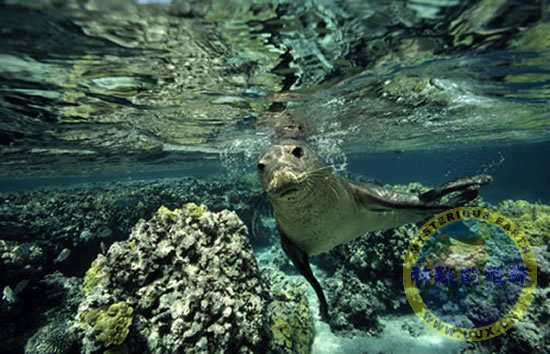Fish Steal Food From Rare Seals, Undersea Camera Shows
Endangered Hawaiian monk seals face rivalry in their search for food, an underwater camera has revealed.
The rare mammals' clever technique for scouting out prey—overturning rocks on the seafloor with their heads—often attracts the attention of other fish, who then nab any food the seals find.
Photograph by Bill Curtsinger/NGS
Rebecca Carroll
National Geographic News
November 27, 2007
Food competition is tough for Hawaiian monk seals in the protected waters of Hawaii's remote northwestern islands.
Scientists suspected that fish were serious competitors of the seals, which are listed as endangered under the U.S. Endangered Species Act.
So they attached small cameras—called Crittercams—to 42 monk seals to see if they could document the seals' interactions with fish.
Crittercam is a National Geographic Society-patented research tool attached to wild animals that combines video and audio recording with environmental data. (National Geographic News is part of the National Geographic Society.)
The Crittercams caught 69 hours of footage—including scenes of jack fish and sharks stealing prey—such as eels and octopi—that were uncovered by the seals.
"We saw seals swimming along, flipping rocks, and then jacks would swim up ahead and wait at the next rock," said NOAA biologist Frank Parrish.
(See an underwater video of the seals hunting.)
"It was pretty clear that if the fish had figured it out, we had better catch up."
(Related news: "Whale Camera Spies On Hawaii's Deepwater Hunters" [February 6, 2004].)
Seal Decline
Only about 1,200 Hawaiian monk seals still live in the wild, and the mammals are declining at a rate of 4 percent a year.
Scientists have been wondering why the protected waters northwest of Hawaii northwest have been more hostile to the seals than the heavily fished seas around the main islands, where a much smaller monk seal population has grown slightly in recent years.
(Download a map of the Hawaiian Islands.)
"Probably one of the keys to that would be the competition," George Antonelis, chief of the protected species division of the NOAA Pacific Island Fisheries Science Center, told an audience at the National Geographic Society's first symposium on Crittercams, held last month in Washington, D.C.
"Monk seals are in trouble—big trouble," Antonelis said. "This is where the Crittercam can really help."
Fewer than one in five Hawaiian monk seal pups survive to maturity, Antonelis said. In Hawaii's northwest waters, the juvenile seals must flee predator sharks and contend for food with mature jack fish that are almost as big as they are.
There are fewer potential competitors in the waters of Hawaii's main islands, and the fish there tend to avoid larger creatures like humans and seals, the scientists said.
But in the protected northwest waters, competitors such as snapper and jack fish follow the seals around.
Unlike their rivals, the seals can flip rocks and dig in the sand to turn up otherwise hidden food. The Crittercam caught the jack fish and snapper following the seals around and snatching up the prey they unearthed, especially in shallower waters.
Crittercam Insights
NOAA's Parrish stopped short of attributing the Hawaiian monk seal declines to the competitors. He said these recent findings were a factor, but more study is needed.
"It wasn't the Crittercam necessarily that gave us the answer," Parrish said, "but it gave the seals the opportunity to point us in the direction ... to take all the other tools that we have."
That story became a familiar one at the Crittercam symposium, as scientists from all over the world described their camera-facilitated discoveries about the secret lives of green turtles, whales, sharks, bears, and more. (Related news: "Leatherback Sea Turtle Mating Filmed for First Time" [February 12, 2004].)
"This is the first time we've all come together to talk about where we are, what we are, what we're thinking about, and specifically, where we want to go," said Crittercam inventor and filmmaker Greg Marshall.
Monk seal research conducted under the Marine Mammal Protection Act, NOAA fisheries permits #898, #848-1335 and special-use permits #HWN0195, #HWN0196, #HWN0597, #HWN0598, #12521-02011, and #12521-02018












